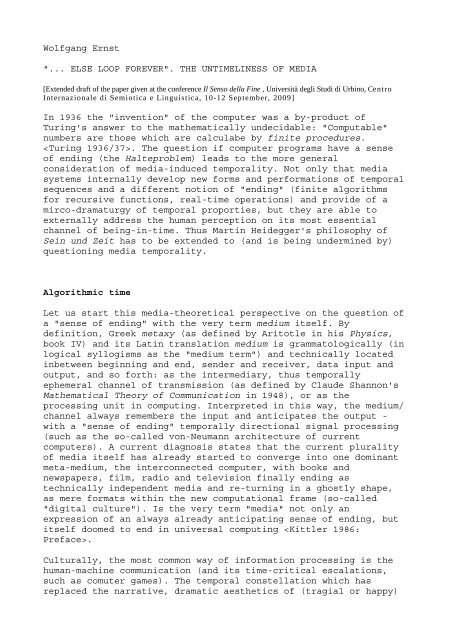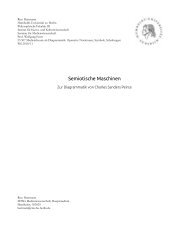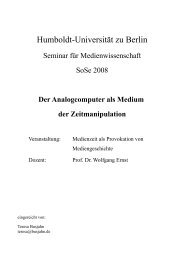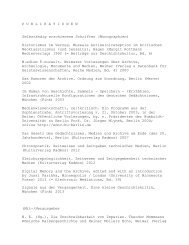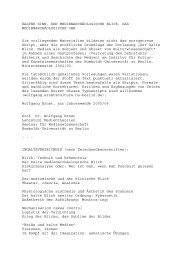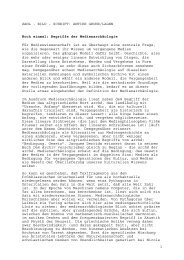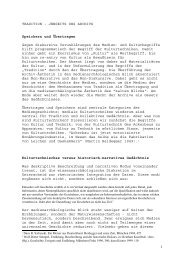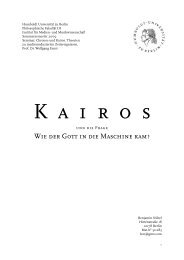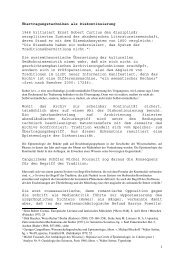"... ELSE LOOP FOREVER". THE UNTIMELINESS OF MEDIA In ...
"... ELSE LOOP FOREVER". THE UNTIMELINESS OF MEDIA In ...
"... ELSE LOOP FOREVER". THE UNTIMELINESS OF MEDIA In ...
- No tags were found...
You also want an ePaper? Increase the reach of your titles
YUMPU automatically turns print PDFs into web optimized ePapers that Google loves.
But wait a minute, have you noticed the two roads are now merging, theLaw road and God’s grace roads are coming together and now you are truly onyour way to eternal life.You see this is the way that God’s Law, His Love and His Grace cometogether. You are cursed by the Law until you make that commitment ofrepentance to Jesus Christ. Then the Law is written in your heart, where theywere previously written on tablets of stone; Or in our example, written on thesign posts to show you the error of your ways.~Standard of Conduct~Let us see how Galatians 3:10 plays into the law.For as many as are of the works of the Law are under a curse; for it is written,"CURSED IS EVERYONE WHO DOES NOT ABIDE BY ALL THINGS WRITTENIN <strong>THE</strong> BOOK <strong>OF</strong> <strong>THE</strong> LAW, TO PERFORM <strong>THE</strong>M."(Galatians 3:10 NASB) (From Deu.27:26)Now that no one is justified by the Law before God is evident;for, "<strong>THE</strong> RIGHTEOUS MAN SHALL LIVE BY FAITH."(Galatians 3:11 NASB) (Hab. 2:4)However, the Law is not of faith; on the contrary, "HE WHOPRACTICES <strong>THE</strong>M SHALL LIVE BY <strong>THE</strong>M." (Galatians 3:12 NASB)(From Lev. 18:5)As one writer put it. So Paul is saying here that those people who havetheir basis of spirituality in their own works and righteousness, rather than intheir Creator, are under a curse. <strong>In</strong> verse 10 above, as with much of the rest ofhis letter to the Galatians, Paul is addressing the problem of “justification” byworks – he is not condemning the law. God’s Law plays a vital part within thesanctification process, because it is during this time in a Christian’s life thatcharacter is being built, that we are growing, overcoming, etc. All this requires astandard of conduct to be present and that standard of conduct is God’s law.This justification is further explained in James 2:10-12. Let us look.6
more information than can ever be represented in artificial,localized memory systems. The notion of infinite-state memory (andorganizational memory) is familiar from systems theory, especiallyfrom the theory of adaptive filters. <strong>In</strong> this model, the parametersare recursively updated by all the received signals, whereby theycan be regarded as a kind of memory for all received information."It seems that the human memory operates in this way". On the other side, there is dynamic memoriesas developed for early electronic computing: (ultra-)sonic "delaylines" and "iconic" intermediary storage, the so-called WilliamsTube, keeping pulse trains (which embody "data", bits respectively"words") in latent memory until they are used (addressed). Theendless delay of the moment of ending is a chrono-rhetoricalfigure known in Christian religion as katechon (articulated byapostle Paul). Already in the world of mass media, starting withthe original radio Soap Opera and culminating in televisionserials, the performance of end-less time, the time of endlessdeferral (the katechontic) has become a cultural form."Siegecraft, once the art of defending the strategic cities ofEuropean states, has become the art of defending the archive".<strong>In</strong> many ways, recycling replaces the teleological direction("sense") of ending - a temporal vector once scientificallyobjectified by the Second Law of Thermodynamics (entropy).The "sense of ending" (Kermode) in narrative and music<strong>In</strong> human physiology, there is no such locatable "sense of time" asit is manifest in the optic, the haptic, and the other biologicalsenses. But still there is something like a "sense of time", butthis experience of time (see Edmund Husserl, "inneresZeitbewußtsein") does not necessarily involve a sense of endingsince this is a specific product of narrative time. The decisivemarks of narrated time are beginning, middle (or climax) and end,connected by a time-line on which the narrative unfolds towardsthe ending. Storage or memory time, on the oppositive, is "emptytime", not dynamically unfolding, but invariant stasis .Narrative as a cultural form of ordered communication alwaysalready implies a sense of an ending. But the sense of (an) endingis not necessarily clothed in narrative form. Narrative (both asliterature, as oral performance and as musical composition)carries the signature of its ending (a Kermodian "sense ofending") already from the beginning. "Music always knows the end",Ernst Bloch once described the narrative dramaturgy of musicalcomposition . What is speficic withmusical time (with music counting as time-based art) is the timecriticalmirco-dynamics of its temporal order, thus modellingtemporality (German "Vergänglichkeit") as such. The human
perception of a melody takes place on the basis of a microtemporalmechanism in consciousness, identifiable as neuronalcorrelation in the brain regions - a different, cybernetical dramaunfolding below the narrative level, closer to mathematicalcounting (of time).Linear time is characterized by sequentially unfolding, aimdirectedevents, with the singular events being linked causally toeach other unfolding. The effect is the impression (and ideology)of a temporal continuum created by a succession of events in whichearlier events imply later ones and later ones are theirconsequences . Ludwig van Beethovens' string quartettop. 135, for example, initially performs this step-by-stepintegration of apparent divergent moments, linearly aiming at aquasi-Hegelian dialectical synthesis at the end). These processesgive the movement a sense of forward motion through time.Sonic temporality (somewhat inbetween physical acoustics and thecultural semantics of music) is conditioned on the one hand by thephysical and physiological laws of acoustics, and by culturaltraining on the other. Kramer points to this cultural condition ofthis temporal aesthetics, as a function of the occidentalphilosophy of progress. 1 A process-oriented analysis of musicaldynamics in occidental musical art reveals that is has been mostlydirected towards an aim towards it unfolds progressively. Againstthis Eurocentristic temporality, Kramer describes non-lineartemporal aesthetics - a "temporal continuum that results fromprinciples permanently governing a section or piece", like knownfrom the isorhythmic motette with its constant pattern of therhythmical process (a "post-historic" condition). For severalreasons - one of which is the technomathematical development ofelectronic media itself - non-linear time has become the dominanttemporal figure in 20th century, where the dominant pieces ofcomposition do not causally unfold any more, neither do they endin a harmonic, conflict-resolving finale. This non-directedlinearity, "gestural time" (Kramer), is a semantic equivalent tomedia-technological Eigenzeit.Writing and TimeThe chrono-entropical directedness of physical (thermodynamical)time becomes "final destination" by the hypothesis of a discursiveimaginary called history; sense (ital. senso) und end thusconverge asymptotically. The frontispiece of Lafiteau's Moeurs dessauvages Ameriquains (1724) shows the encounter of writing andtime in a closed space littered with relics from both ClassicalAntiquity and the New World. The muse of history (Clio) holds thepen, the allegory of time (Chronos) the scythe (in German:1Hans-Ulrich Fuss, Musik als Zeitverlauf. Prozeßorientierte Analyseverfahren in der amerikanischen Musiktheorie,in: Zeitschrift der Gesellschaft für Musiktheorie 2/3 (2005); here quoted from the online-Versionhttp://www.gmth.de/zeitschrift/artikel/205.aspx (accessed July 2009)
"Sense", another senso); both tools approach each otherasymptotically without ever touching .The idea of historical time, according to Vilém Flusser, is animplication of alphabetic writing which reduced themultidimensionality of architecture and images to linear,sequential lines. According to Marshall McLuhan, the invention ofthe printing press, i. e. the mechanized form of alphabeticwriting as a further escalation, gave rise not only to perspectivein Renaissance painting, but as well "print produced the idea of apast in distant perspective" which isdirectional, end-orientated time. Historical consciousness, readthis way, is the direct function of a specific media technology.The loss of historical consciousness as reference for theselection of information in combination with the increasingtechnological manipulation of time leads of the simple storage ofall incoming data - starting with the E-mails on almost everyprivate computer desk. The end of history is the future of thearchive, a kind of post-historical condition not to thing inlinearities any more, but to calculate with discreet states.Storage, according to the mathematical theory of communicationengineering, is the pre-condition for all transfer.The moment when facts are disseminated by news media, they gain akind of kinetic energy which divorce them from their originalcontext and throw them into hyperspace where they loose anypointed direction, de-referentialized, with no more teleology(which is the condition for the discourse of history as sensedrivennarrative). When events are not only registered but as wellwritten (historio-)graphically with no more sense of ending, whatremains in the end are listings - a reduction of narrative to itsessentials, like On Kawara's "date art" paintings. The artisticwriting systems of Hanne Darbovens as well turn what used to benarrative historiography into lists of dates (e. g. Bismarckzeit,1978): pure serial writing (corresponding with the computationalhistoire sérielle in the Franch school of historians around thejournal Annales), pure description. Narrative elegance is beingreplaced by mathematical procedures of time series.Game timeLive is not really, but only symbolically organized in stories;this sense-giving machinery gets in ekstasy when the end ofnarrative texts coincides with the expecation of the end of time(a sense of ending).<strong>In</strong> traditional media the relation and distribution of linearityand non-linearity mostly converges with the patterns ofnarrativity. Narration produces in its classical structure ofbeginnging, midlee and end, a linearly unfolding sequence whichallows for non-linear couplings, differering according to the
individual laws of media. While movies represent closed blocks oflength, television developed the weekly series and its repetition.With hypertextual media (computer games, and the World Wide Web),non-temporal modes of beginning and end become aquainted:hypertime. The point and moment to step in is almost arbitrary.Expressed in the mathematical theory of graphs, an adventurecomputergame is defined by a beginning and an ending (almost„Homeric narrating“, according to Erich Auerbach): everythingwhich happens between point a and point b in binary spacepartitioning.While human memory remembers the same response to the same signal,a counting function counts it different each time . This is non-narrative time in action, replacingraconter (in French) by conter, disrupturing narrative (German"Er/zählung"). For the first time, in the so-called digital agehistoriography does not take place on the symbolical level of thephonetic alphabet exclusively, but on the level of electronicallyembodied alpha-numerics. <strong>In</strong> binary form the year 2000, f. e.,appears as numerical string „11111010000“, reminding us not to beseduces by narrative suggestion, but to calculate in discretestates, with the consequence not to tell events intransitively butto count them transitively, quantizing data. The media theoristLev Manovich (in a chapter of his book The Language of New Media)calls this the aesthetics of data banks, corresponding with adata-archaeological information ascetitics. Beginning and end, incomputing media, are not structured by dramatical structures anymore, but dramaturgische Struktur, but by the (equally complex)logic of count down.The "Y2K problem" and the non-sense of ending<strong>In</strong> spring 2009, I received per e-mail a strange message sent fromthe computing service of my university (Humboldt University,Berlin): The storage capacity of my account was close to overloadand memory capacity will expire soon. Having passed the firstmoment of astonishment, my assistant (Felix Pfeifer) pointed atthe date indicated for this temporal limit: "1.1.1970" - thebeginning of "system time" in IBM computers. This apparent jokenevertheless is indexical for the being-to-death of computingtime.Almost ten years ago, a computational problem (both in ArnoBorst's sense of medieval computus as time-counting and in thesense of mechanized data processing) almost led to a collectivepanic for the so-called post-industrial information society: themillenium bug. The so-called "millenium bug" reminded ourinformation society of its very temporal being-to-death. There isa close connection between the temporal, destinational logic of
narrative texts and apocalyptic expectations. Most computers sofar had been programmed in such a way that the step into the 21stcentury - without laborious intervention - meant a jump back intime, so the 1st January 2000 was indicated as the 1st January1900. The reason for this lied hidden deep within the operatingsystem - a media-archeological deep time. The jump from 1999 to2000 (in chronological time) as a jumping back to 1900 (incomputational time) was not biased by philosophical musing on theende of history any more, but has been triggered by integratedcircuits. The computer-temporal bomb namend the Y2K problemreminded the post-historical society drastically that its temporalorder is no more a function of philosophy of history but of datastorage economy, since in the early years of digital computingmemory space had been the most precious commodity. Thus the Y2Kproblemturned out to be a function of the technomathematialarchive to which the philosophical notion of "beginning" and "end"is alien. The millenium-bug thus turned out to be (like allkatastrophies) a chance as well: the liberation from the culturalsupremacy of narrative. With the "millenium bug", the mightycultural engineering of calendar time turned out to be no more thepriviledge of the church (like in medieval times) or of learnedsocieties (like in the modern age). Calculating time turned out tobe a technical historicity from now on - a temporality to whichhuman concepts of time are increasingly subjected .The idea of historical time, according to Vilém Flusser, is animplication of alphabetic writing which reduced themultidimensionality of architecture and images to linear,sequential lines. According to Marshall McLuhan, the invention ofthe printing press, i. e. the mechanized form of alphabeticwriting as a further escalation, gave rise not only to perspectivein Renaissance painting, but as well "print produced the idea of apast in distant perspective" which isdirectional, end-orientated time. Historical consciousness, readthis way, is the direct function of a specific media technology.The loss of historical consciousness as reference for theselection of information in combination with the increasingtechnological manipulation of time leads of the simple storage ofall incoming data - starting with the E-mails on almost everyprivate computer desk. The end of history is the future of thearchive, a kind of post-historical condition not to thing inlinearities any more, but to calculate with discreet states.Storage, according to the mathematical theory of communicationengineering, is the pre-condition for all transfer.The moment when facts are disseminated by news media, they gain akind of kinetic energy which divorce them from their originalcontext and throw them into hyperspace where they loose anypointed direction, de-referentialized, with no more teleology(which is the condition for the discourse of history as sensedrivennarrative). When events are not only registered but as wellwritten (historio-)graphically with no more sense of ending, what
emains in the end are listings - a reduction of narrative to itsessentials, like On Kawara's "date art" paintings. The artisticwriting systems of Hanne Darbovens as well turn what used to benarrative historiography into lists of dates (e. g. Bismarckzeit,1978): pure serial writing (corresponding with the computationalhistoire sérielle in the Franch school of historians around thejournal Annales), pure description. Narrative elegance is beingreplaced by mathematical procedures of time series."Ubiquitous oscillations" versus transient phenomena: Signals ofending in electronicsActive sonar in submarine communication creates a pulse of soundcalled a "ping", and then waits for reflections of the pulse. Thetime from emission of a pulse to reception is being measured,traditionally by use hydrophones to measure the relative arrivaltime to each in a process called . The ping signal,when fading out, resembles the outfading oscillations in earlyspark-driven telegraphy which was turned into stabilized,continuous oscillations only by the electronic vacuum tube infeed-back circuits. Only this allowed for the transmission ofcarrier-wave-modulated speech and music, as opposed to discreetMorse code. Let us compare this with the process of a swingingstring. A pulled string at an instrument with a fading pitchanticipates the infinite swinging out from the sudden, transientstart. <strong>In</strong> the real, that is: physical world the picked stringfades out during to mechanical loss of energy (Heidegger's "beingto-death"in its mechanical sense), like a swinging pendulum, likethe echo in the sonosphere. <strong>In</strong> 1948, Dennis Gabor criticized theidealism of harmonic Fourier analysis: the hyothetically endlessand beginningless periodic waves miss the temporal (eventual)aspect of a sound happening in the world, for example a key strokeat the piano, or a string touched - that is, the moment when anidealized model becomes an event in the real, that is:temporalized world. It was the temporal delay manifest in echoacoustics which already led Aristotle to the hypothesis that theremust be a resistant "inbetween" (in this case: the air) whichfunctions both as a carrier and a restistance to the propagatedsound - to metaxy, giving birth to the first genuine media theory.Both the pulled string and the articulated echo, by their veryfading out, reveal the endlichkeit (the temporal limit) of anyphysical event. The moment a string is pulled or a sound isarticulated, like a breaking wave, nature already anticipates andsenses its very end, almost instantaneously but strictly temporal(like electromagnetic induction which is - as calculated by JamesClerk Maxwell - very fast indeed but not instantaneous). <strong>In</strong> 1879Hermann von Helmholtz initiated a prize by the Berlin Academy ofSciences to answer the dispute on the essence of electricity: thetheory declaring no wave-like transmission but rather an immediatereaction (in the tradition of Newtonean physics) versus Maxwell's
mathematical theory of electromagnetic waves as part of anencompassing electromagnetic spectrum like light, thus subject totemporality, a limited speed. Radio waves, as turned out byHeinricht Hertz' experiments on the very media-archaeologicallevel (that is, before becoming part of a mass-medium called"radio"), have a sense of ending on the very electrophysicallevel; the secondary level is the modulation of the carrier wavesby the proper radio program which by its very format nature isending by arbitrary cultural and media-economical decisions.Time-to-live and ping-to-death: <strong>In</strong>ternet temporalityThere is a "semiotic" use of signs of ending on the micro-temporallevel which is the operative temporality of electronic media:linearities which are nevertheless not narrative, anddiscontinuities which are the precondition for what humanphysiologically perceive as continuous movement in space (thekinematographic effect). The electronic (analog) image on thetelevision screen is being scanned by the scanning finger of thecathode tube ray line by line. After such a line has beencompleted, a special signal indicates the cathode beam to jumpback to write another successive line. A different kind ofsynchronization impulse indicates the completion of whole imageframe, to start anew.The programming of computers always involves a local sense ofending, since it has to pay respect to the time-critical questionof data-synchronisation. When a code is literally "run" by themachine, a so-called profiler finds out how long the machine takesfor the respective operations. A similar time-critical mode istrue for communication in the World Wide Web. The ICMP protocoloperates on the basis of echo request and echo reply. The sourcecomputer sends small data packets of the type echo request to thedestination computer. <strong>In</strong> case these packets reach theirdestination, it replies with the type echo reply; thus the dataconnection between two machines can be chequed and disturbances bedetected. But these control data can be misused, leading to theso-called "ping of death" and ping flooding. "Ping of death"stands for oversized data packets which once lead some TCP/IPstacks to collapse, destroying the machine configuration. "Pingflood" means the echo requests are being targetted with thehighest possible speed; the destination computer thus is so busywith answering that he can almost not be used for its poper tasksany more.What happens in the computational background of "Ping Timeout"?Between the local PC and the IRC server keep-alive-singals arebeing sent back and forth: the "pings". When no answer occurswithin a certain pre-defined temporal interval, the line is beingset back automatically. The whole procedure can appropriately becalled a Ping-Pong game. <strong>In</strong> TCP/IP as fundamental network program,
techniques of synchronisation meet a deadly economy of time. "Timeto live" means that each daten packet is assigned a given lifespan; "Time to die" stands for the crucial signature of theinformation age .A mathematical anticipation of endingTechno-mathematics operates in an untimely mode (to make use ofFriedrich Nietzsche's German notion of "unzeitgemäß").Oswald Spengler starts volume I of his classic Untergang desAbendlandes with his notorious chapter on "The Sense of Numbers". He criticizes modern "Faustean" science for itsemphasis on mathematical laws of causality which do not catch theunpredictability of life which is rather a function of destiny.According to Spengler, future live can be sensed, but notcalculated. Soon after Spengler, Western science managed to copeeven with destiny and unpredictability in mathematical terms:linear prediction by stochastic calculation and harmonic analysis,as developed by Norbert Wiener. Linear prediction (which inlinguistic grammar is futurum exactum) pracitcally means theanticipation of the past in the future. This chronotopos of "pastin the future" has been developed as a mathematical tool for antiaircraftartillery in the Second World war, leading from theanalogue computer (Vannevar Bush's Differential Analyzer) to thefirst electronic computers.With anticipatory targeting (known from human "musical"perception, such as melody recognition as analyzed by HenriBergson as much as by Edmund Husserl), such a directional "senseof ending" opens a temporal horizon, in fact: it temporalizes theapparent momentary presence into an augmented presence. What hasbeen described by Edmund Husserl (examplified by the humancapability to grasp a musical melody) as "inneres Zeitbewußtsein",a temporal horizon consisting of re- and protentions, has becometechnomathematical in real-time computing (since the storedprogram computer, the so-called von Neumann architecture ofcomputing) which - seen under that aspect - is "musical" incharacter. <strong>In</strong>deed, this form of temporal integration is known fromhuman physiology and in linguistics, when it comes to (Husserlian)semantic pro- and retention in sentence-building, such as thebackwards-correction of the meaning of a word. A similarphenomenon is the perception of a musical melody when there isdiscreet sonic pulses in (physical) reality. Each attentiveperception involves always already an expectation, resulting fromthe evaluation of what has just be perceived by mixing it with thememory of previously perceived impressions. Thus during the socalledpsychic time of presence the immediate future is alreadybeing calculated. "Bergsonean time" (as mentioned in a chapter ofNorbert Wiener's Cybernetics), which is the experienced event time(temps durée), differs from the physical time in science (tempsespace). Is it therefore - referring to Husserlean phenomenology -
an anthropologically (or better: neuro-physiologically) groundedtendency to predict from past events a future behaviour of timeseries. <strong>In</strong> the case of music, the cognitive hypothesis states thatthe physically heard signals will be reproduced in one way or theother in the immediate future ("Protention"). It is suchprojective fields which account for an impresison of regularity -a role traditionally ascribed to the abstract notion of prescribedmetrum .Sensors for targets (rockets, trajectories)The meaning of the end and the sense of ending are closelycoupled. There is a complex and controversial relationship betweenthe ideas of the end and of sense, with "sense" here referring tothe physiologically sensual (neurologically and electrotechnically)signal-based, but to "meaning" as well - anambivalence kept in Italien (senso). Let us look at the pluralityof semantics. Latin finis means border, limit, end, achievement,goal, final aim, purpose, equivalent here to Greek telos. It hasbeen a technological paradigm of 20th century communicationtheory, in fact cybernetics, which gave a hitherto metaphysicalnotion an epistemological twist for both humans and machines, asexpressed in Norbert Wiener's writing on "Behaviour, Purpose, andTeleology", cultivating a non-deterministic, still teleologicallyorientated theory of feed-back . Between target anddestruction, on one hand, finis means end and ruin, whereas, onthe other, result, achievement, aim. This polysemanticity is keptin Italian, but as well is resonant in elaborate German language,f. e. in G. W. F. Hegel's notion of the "end" of art ("Ende" hereequals "Vollendung", fulfillment).Military techno-mathematics is less metaphorical here, orexpressed the other way round: it is literally metaphorical (with"metaphor" naming "transfer"). Archytas of Taranta once explainedacoustic sound kinematically: a really media-archaeological,process-orientated explanation indeed. His kinematic (or dynamic)description of sound as crash of objects with air most probalyresults from the poetic notion of the voice as missile . Archytas recognized the essence of sound from its temporalnature (and thus its frequency avant la lettre), analyzing thathigher sound (the pitch) results from higher speed. <strong>In</strong> ballistics,the final destination has been a function of mathematicalcalculation, giving rise to a plethora of new methods. A shell[Geschoß] has to be imbued with an in-built "sense of ending" inorder to arrive at its planned destination, culminating with theGerman V1 rocket in World War II and its pre-calculatedtrajectory. With the V2 rocket a further escalation happened: Aself-correcting mechanism (a kind of Analog Computer, the in-built"Mischgerät") was able to correct aberrations during thetrajectory ("on the fly") - a technomathematical sensorium ofending. We know the image from Iraq War II: The ending of the
trajectory is the final hit of the missile which corresponds withits self-destruction, as expressed by the title of David Mindell'sPh.D. thesis in 1996 (Cambridge, Mass.): Datum for its OwnAnnihilation. But still, the trajectory is planned to be more orless linear and allows for linear prediction.An epistemologically more delicate situation arrives with theanti-aircraft artillery in WWII, when the "enemy" pilot isexpected to try to manoeuvre around the artillery trajectories.The artillery thus has to anticipate not only the immediate futureposition of the enemy aircraft, but as well the possible countermanoeuvresof the pilot to escape this linear prediction. For thatreason, a modification of the trivial pre-calculated fire tableshas been developed which lead to the rise of a mightytechnomathematical tool: the electronic analog, then: digitalcomputer. The Mark 1 Ford Rangekeeper on a battle-ship in WorldWar I had the purpose to calculate in real time, that is: in themedium of temporality itself (as the only stable variable) theenemy ship's course and speed, to extrapolate these data into thefuture, and the to aim where it was expected to be: amathematically "calculated" sense of ending, embedded within amechanic analogue computer. If one entered an inital range, themachine calculated the range into the future. A similar mechanomathematicswas applied in the later Sperry T-6 anti-aircraftdirector. "The computer performed prediction, or leading thetarget, modeled its motion and extrapolated it to some time in thefuture" . The figure of time here is thegrammatical future-in-the-past, based on a feedback operation: Thedirector multiplied the calculated velocity of the target by theprediction time "to determine a future target position and thenconverted the solution back into polar coordinates for output". Thus the machine represented a worldly, that is:timely process by a physical model. <strong>In</strong> order to do so, theclassical firing table data were mechanically fed into thiscomputer as a kind of permanent memory, "roughly comparable towhat today we would call ROM, or read-only-memory" . Ballistic and prediction calculations formed a feedbackloop, with the aim of minimal dependance on the so-called humanelement.A photography of a German rocket attack, reproduced in Mindell'smedia-archaeological analysis, shows continuous and discretesignals agonistically coexisting in the air - the anti-aircraftsystemshooting down a buzz bomb. The missile enters at the left,is hit by a shell, crashes, and explodes. The white dots are shellexplosions, which continue to statistically track the predictedposition of the target" . This is theappropriate moment for this text to end - or should I write: STOP?Literature
Jean Baudrillard, Das Jahr 2000 findet nicht statt, Berlin (Merve)1990same author, The Illusion of the End, Stanford, Cal. (StanfordUniversity Press) 1994Michel de Certeau, Writing versus Time, in: Rethinking History,ed. M.-R. Logan / J. F. Logan, New Haven: Yale French Studies 59(1980)Götz Großklaus, Medien-Zeit, Medien-Raum: zum Wandel derraumzeitlichen Wahrnhemung in der Moderne, Frankfurt/M.(Suhrkamp) 1995Gotthard Günther, Das Bewußtsein der Maschinen. Eine Metaphysikder Kybernetik, Krefeld / Baden-Baden (Agis), 2nd ed. 1963,supplement IV, 179-203Christopher Hasty, Meter as Rhythm, New York / Oxford (Oxford UP)1997Martin Heidegger, Sein und Zeit (orig. 1927), Tübingen (11th ed.)1967; 15th ed. 1979Frank Kermode, The Sense of an Ending. Studies in the Theory ofFiction, Oxford 1967Sebastian Gießmann, Netzwerk-Zeit, Zeit der Netzwerke. Fragmentezur Datenökonomie um 1960, in: Volmar (ed.) 2009, 239-254Sandrina Khaled, Psóphos und Phoné. Die mathematischeFormalisierung des Hörbaren in Archytas von Tarents Harmníkos, in:W. E. / Friedrich Kittler (eds.), Die Geburt des Vokalalphabetsaus dem Geist der Poesie. Schrift - Ton - Zahl im Medienverbund,Munich (Fink) 2006 (series Kulturtechnik, vol. 5), 153-170Friedrich Kittler, Grammophon - Film - Typewriter, Berlin(Brinkmann & Bose) 1986Teuvo Kohonen, Self-Organization and Associative Memory, Berlin /Heidelberg / New York / Tokyo 1984same author, Self-Organizing Maps, Berlin / Heidelberg / New York(Springer) 1995Jonathan D. Kramer, The Time of Music. New Meanings, newTemporalities, new Listening Strategies, New York (Schirmer)1988Marshall McLuhan, The Gutenberg Galaxy, Toronto (University ofToronto Press) 1962David Mindell, David A. Mindell, Between Human and Machine.
Feedback, Control, and Computing before Cybernetics, Baltimore /London (Johns Hopkins University Press) 2004Marvin Minsky, Computation. Finite and <strong>In</strong>finite Machines,Englewood Cliffs, N. J. (Prentice-Hall)Shintaro Miyazaki, Das Algorhythmische. Microsounds an der Schwellezwischen Klang und Rhythmus, in: Axel Volmar (ed.), ZeitkritischeMedien, Berlin (Kulturverlag Kadmos) 2009Klaus Peter Richter, Zeitfenster des Augenblicks, in: FrankfurterAllgemeine Zeitung No. 128 (4th June 2003)George Spencer-Brown, Laws of Form, Portland, Ore. 1994Oswald Spengler, Vom Sinn der Zahlen, in: Der Untergang desAbendlandes, vol. 1, Munich (Beck) 1923, 71-122Alan Turing, On Computable Numbers, with an Application to theEntscheidungsproblem, in: Proceedings of the London MathematicalSociety (2), 42(3), 1936, 230-265; 43(7), 1937, 544-546Francisco J. Varela, The Specious Present. A Neurophenomenolgy ofTime Consciusness, in: Jean Petitot / ders. / Bernhard Pachoud /Jean-Michel Roy (eds.), Naturalizing Phenomenology. Issues inContemporary Phenomenolgy and Cognitive Science, Stanford(Stanford UP) 1999, 266-316Peter Wegner, Why interaction is more powerful than algorithms,in: Communications of the ACM, vol. 40, no. 5 (May 1997), 80-91Norbert Wiener, Behaviour, Purpose, and Teleology, in: Bulletin ofMathematical Biophysics, vol. 5 (1943), 114-133Online sourcesWikipedia, entry "Halting problem",http://en.wikipedia.org/wiki/Halting_problem (accessed 7thAugust, 2009)Wikipedia, entry "Hydrophone",http://en.wikipedia.org/wiki/Hydrophone (accessed 7th August,2009)Wikipedia, entry "Numerische Mathematik", http://de.wikipedia.org/wiki/Numerische_Mathematik (accessed 4th June, 2009)Wikipedia, entry "Finite-state machine", http://en.wikipedia.org/wiki/State_machine (accessed 16th February, 2009)


